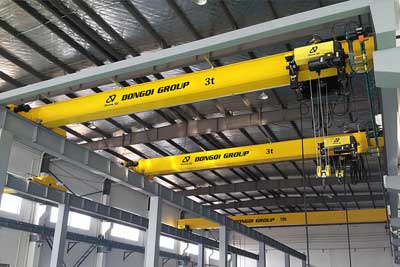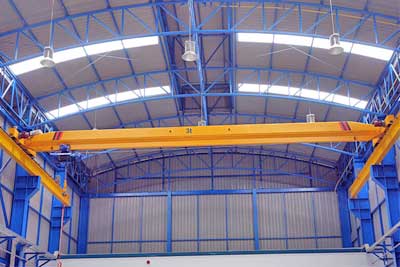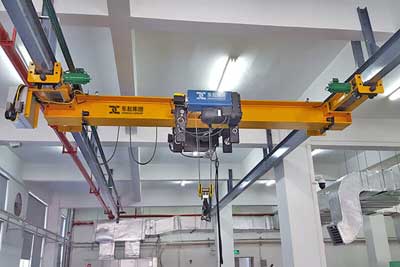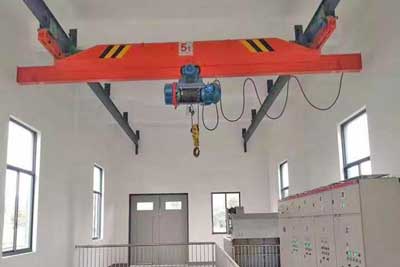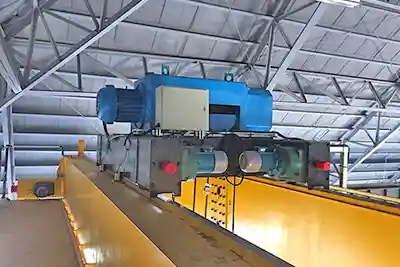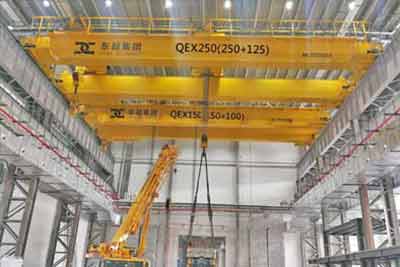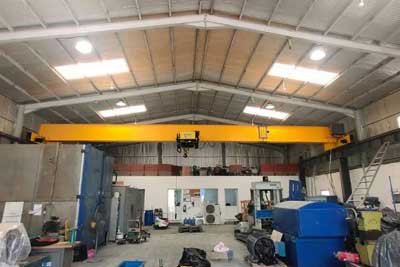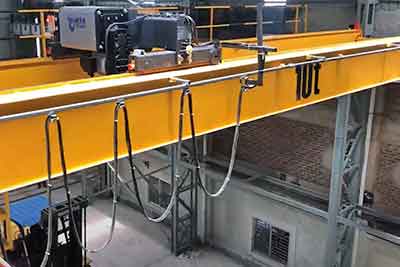Bridge Crane: Single Girder vs. Double Girder Bridge Cranes
How to select from single girder & double girder bridge crane? What 's their features ? Check Single girder & double girder bridge crane comparison now!
A bridge crane's girder type should be determined by application and building conditions and lifting requirments rather than crane price. Despite the fact that single girder bridge cranes are less expensive than double girder bridge cranes, each is the best tool for its intended application.
Single Girder Bridge Cranes
Single-girder bridge cranes are ideal for light to moderate duty applications such as production or maintenance. Single-girder bridge cranes have one girder attached to the crane's end trucks, which run on runway rail that runs the length of the building. With single-girder bridge cranes, the electric crane hoist is underrunning, with the cross travel trolley generally running on the bridge girder's lower flange. Bridge girder construction of wide flange beams under 65' span and fabricated single box girder over 65' span limits single girder bridge cranes to 20 ton capacity. The overall span is approximately 130'.
Because the hoist is suspended under the bridge girder, single girder bridge cranes typically require less space over the top of the runway beam to the lowest obstruction of the building. Many existing buildings have runways installed at a high point within the structure, limiting available clearance for the use of only single girder bridge cranes.
If the application is simple production or maintenance and the duty requirement is light to heavy, a single girder crane should be adequate.
Advantages of Single Girder
- Less upfront cost due to less material and faster installation.
- The most cost-effective light-to-medium-duty crane option.
- Reduced stress on the building structure.
- Improved hook height for trolley and bridge travel.
- Installation, service, and maintenance are simplified.
- If the building has enough headroom, this is a good option.
Cons of Single Girder
- Because the hoist is usually located beneath the girder, the hook height is reduced.
- Under-running trolleys can cause premature beam wear.
- Special features such as service walks and lighting can be costly or difficult to install.
- Weight capacity is limited.
- Crane span is reduced.
Double Girder Bridge Crane
Double girder bridge cranes are ideal for larger capacities, longer bridge spans, and higher duty cycles. Double girder bridge cranes have two girders attached to the crane's end trucks, which run on runway rail that runs the length of the building. The hoist on a double-girder bridge crane runs on rails installed on the tops of the girders, with the hoist spanning the gage of the two girders. Because the hoisting machinery is on top of the girders rather than below, double girder bridge cranes are typically used for heavier loads, longer bridge spans, and improved hook height. The capacity of a double girder crane can exceed 100 tons, with spans exceeding 150 feet.
Because the hoisting trolley runs above the bridge girder, double girder bridge cranes typically require more space over the top of the runway beam to the lowest obstruction of the building. As a result, where a double girder crane is desired, there must be 4' or more of runway clearance to the lowest obstruction. This over-the-runway clearance requirement grows with crane capacity, unless the hoist is dropped between the girders, which is generally expensive. Many special applications such as heavy production, coil handling, and turning of loads with dual hoists are best served through the use of Double girder bridge cranes.Yuantai Crane has application professionals in each of our offices that can assist you in determining the correct crane and hoist type for your application. We design, fabricate, and install single and Double girder bridge cranes out of our regional fabrication facilities that ensure efficient delivery and high-quality control. When ready to specify your next crane, give your local Yuantai Crane branch office a call.
Pros of Double Girder
- Larger crane structure are easier to handle more weight and larger loads
- Cane span can be designed with longer length
- Greater hook height is provided be placing the trolley on the top of the two girders.
- No limits on its loading capacity .
- Added features like catwalks, cabs, or lights are available.
- The double girder bridge cranes can be used indoors or outdoors
- Easy to maintain
Cons of Double Girder
- More costly due to additional material, structural support, and intricate components
- Greater setup fees.
- Lessening of the hook approach for bridge or trolley transit
Single Girder vs. Double Girder Top Running Bridge Cranes
Determining when to employ a single girder overhead crane as opposed to a double girder overhead crane is a part of the application study for a crane system. A single girder crane is often less expensive than a double girder crane, but there are other considerations to make since each have advantages and disadvantages for certain uses.
An industrial overhead bridge crane's basic framework consists of trucks with wheels that travel the length of the runway system, the bridge crane girder fixed to the ends of the trucks, and the hoist trolley that travels over the bridge while suspending the hoist.
The difference between a single and double girder top running bridge crane is:
- · A single girder bridge crane has only one bridge beam, and the hoist trolley operates or travels on the bridge girder's lower flange.
- A double girder bridge crane has two bridge beams, and the hoist trolley travels on rails that are typically attached to the tops of the crane girders.
Bridge Girder Construction
There are two basic methods of bridge crane girder design for both types of bridge cranes:
Standard structural steel bridge girder: An I-Beam or Wide flange beam is a common structural beam that is readily available from structural steel suppliers. When used for shorter bridge crane spans and capacities under 30 Ton, these beams offer cost, availability, and efficiency advantages. Furthermore, a structural beam requires very little engineering and only minor fabrication to connect to the appropriate end truck via connection plates. Structural beam spans are typically limited to 60', with slightly longer spans available when ordered in a special mill run.
As bridge crane spans and capacities grow, so do the required hook height and weight per foot of wide flange girders. Higher capacity cranes and those with longer spans may have very heavy and long girders in many cases.
- Engineered and fabricated box girder design : Box Girder cranes rely on a specially designed and expertly fabricated box beam section that must meet national crane requirements on specifications. As a result, the box girder has significantly higher engineering and fabrication costs than a simple structural girder. The benefit of the box girder design is longer spans and higher capacities. In these applications with spans greater than 60' and capacities greater than 20 Tons, the cost of engineering and fabrication can be offset by lower material costs because a box beam uses less steel while remaining equally strong.
- Due to the length limitations of standard structural beams, a box girder section is the only option when a crane weighs more than 30 tons or spans more than 60 feet. The ability to design the girder depth to improve hook height is another advantage of box girders, and the lower weight of the box reduces the structural requirements of the runway design by lowering crane loads on the runways and support columns.
Duty Classification:
Many people mistakenly believe that a double girder crane is more powerful than a single girder crane or that it will last longer. That assumption is incorrect because the components (End Trucks and Hoist with trolleys) can be of the same duty and configured in a single or double girder design. When the duty requirement is Very Heavy Duty or Severe Duty, a double girder crane is typically used because the special hoisting equipment frequently includes an open winch with a separate split gearcase, heavy-duty motor, and a brake mounted on a deck frame.
In addition, for the safety and convenience of technician service and repair access to the hoist and crane components, heavy-duty or critical applications frequently include a bridge-mounted footwalk or maintenance platform. Mounting an effective service platform to a single girder crane is typically impractical.
Headroom Limitations:
According to OSHA, the crane or hoist must have 3" of clearance between the lowest building obstruction, including lights, HVAC, and sprinklers, and the moving crane or hoist. Because the hoist trolley travels the top of the crane bridge girders, double girder bridge cranes generally require more clear height over the elevation of the crane runway beams. Because the hoist travels on top of the bridge crane girders, the hoist hook height is generally significantly greater than with a single girder crane.
Because there is insufficient clearance above the runway girders in many existing runways to accommodate a standard double girder crane, a single girder design is the most practical. When there is insufficient clearance, the crane girder can be stooled up to increase the available hoist hook height. The hoist trolley on a single-girder bridge crane traverses the girder's lower flange. In addition, the beam will most likely be deeper than a double girder. As a result, the available hook height of a single girder crane will most likely be less than that of a comparable double girder crane.
Structural Differences
Within the entire structure of a single girder EOT crane, there is only one girder. A double girder, on the other hand, has two girders. What exactly are girders? In layman's terms, girders are the metal beams that connect the side travelling mechanisms.
- An electrical hoist travels on the lower flange of a single girder's sole and main girders. The double girder crane has no hoist. Instead, it employs a crab-shaped mechanism that spans both girders.
- Only one girder EOT cranes do not require separate cross-traveling rails and platforms for part-time maintenance. Others, on the other hand, are required to meet these requirements.
- Continuous platforms are not available in single girder bridge cranes. In total, there are three platforms: two small ones around the motor and one for panel maintenance. A double girder machine has a continuous platform and a different platform in addition to the crab-shaped structure.
- There are no set schedules for factory technicians and repairers. They are occasionally required to work at night. Double girder machines are preferable in these situations because they include under bridge lights, which reduce the risk of accidents. This feature is not available on EOT cranes with a single girder.
- The engines and gearboxes on these cranes also vary significantly. On single-girder cranes, flange-mounted engines and modular gearboxes are standard. Foot-mounted engines and horizontal gearboxes are common features of double-girder bridge cranes.
Application and Function Differences
Double girder bridge cranes are better suited for higher duty class and special applications such as die flipping and double hoisting systems. Large control panels for specialized functions can be easily accommodated on the optional service platforms on a double girder crane. Die flipping with dual hoists necessitates the installation of hoisting drums parallel to the crane runways. A double-girder crane is ideal for this task.
The difference Based on Functional Differences
- The pendent and radio remote system can be used to monitor a single girder crane. You won't be able to do so, however, because you don't have access to the operating cabin. All three options are available in the case of a double girder EOT crane.
- To stop the function, a single girder crane can only provide a DC disc brake. However, in a double girder, the DCdisk brake and EHT brake combination is available with no brake-use restriction.
- Using a snap action limit switch, operators of a single girder crane can control the hoist's up-and-down movement. The function of the switch is activated by a wire rope guide. On a double girder crane, a geared rotary limit switch allows you to control the crane. This system is capable of determining the movement of the hook and limiting its up-and-down movement.
- The maximum span and lifting capacity of the functional area are also different. The maximum functional area of a single girder crane is approximately 30 metres. It can lift up to ten tonnes at one time. A double girder crane has a much larger functional area as well as a much higher lifting capacity than a single girder crane. A double girder crane can lift and move weights of up to 500 tonnes.
- Single girder bridge cranes are typically used for lighter loads and are capable of handling common materials. A double girder crane, on the other hand, can be used for any application and can handle any type of material.
- Because of its lighter weight, a single girder crane has a much lower wheel load. The crane's size is accommodated by the small gantry girder. Due to the heavier weight of a double girder crane, the gantry girder size is undoubtedly larger.
- A double girder crane is slightly more expensive than a single girder crane. As the weight-bearing capacity and size increase, so does the price. Double girder bridge cranes, on the other hand, are easier to manage and less expensive to maintain than single girder bridge cranes.
It is best to leave the precise application of a crane to a qualified applications specialist. Yuantai Crane is a market leader in the design and installation of bridge crane systems in both new and existing structures. Our experts can assist you in selecting the appropriate crane style as well as the features required to make the installation safe, dependable, and efficient.


